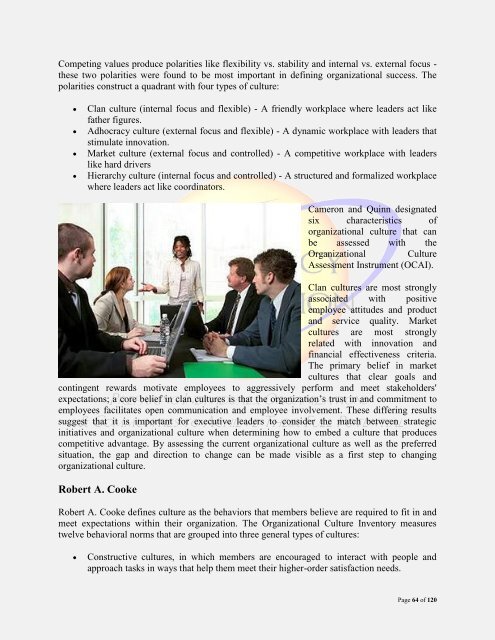Organizational Development - Vol. V, Part II
Organizational Development - Vol. V, Part II
Organizational Development - Vol. V, Part II
Create successful ePaper yourself
Turn your PDF publications into a flip-book with our unique Google optimized e-Paper software.
Competing values produce polarities like flexibility vs. stability and internal vs. external focus -<br />
these two polarities were found to be most important in defining organizational success. The<br />
polarities construct a quadrant with four types of culture:<br />
<br />
<br />
<br />
<br />
Clan culture (internal focus and flexible) - A friendly workplace where leaders act like<br />
father figures.<br />
Adhocracy culture (external focus and flexible) - A dynamic workplace with leaders that<br />
stimulate innovation.<br />
Market culture (external focus and controlled) - A competitive workplace with leaders<br />
like hard drivers<br />
Hierarchy culture (internal focus and controlled) - A structured and formalized workplace<br />
where leaders act like coordinators.<br />
Cameron and Quinn designated<br />
six characteristics of<br />
organizational culture that can<br />
be assessed with the<br />
<strong>Organizational</strong> Culture<br />
Assessment Instrument (OCAI).<br />
Clan cultures are most strongly<br />
associated with positive<br />
employee attitudes and product<br />
and service quality. Market<br />
cultures are most strongly<br />
related with innovation and<br />
financial effectiveness criteria.<br />
The primary belief in market<br />
cultures that clear goals and<br />
contingent rewards motivate employees to aggressively perform and meet stakeholders'<br />
expectations; a core belief in clan cultures is that the organization‘s trust in and commitment to<br />
employees facilitates open communication and employee involvement. These differing results<br />
suggest that it is important for executive leaders to consider the match between strategic<br />
initiatives and organizational culture when determining how to embed a culture that produces<br />
competitive advantage. By assessing the current organizational culture as well as the preferred<br />
situation, the gap and direction to change can be made visible as a first step to changing<br />
organizational culture.<br />
Robert A. Cooke<br />
Robert A. Cooke defines culture as the behaviors that members believe are required to fit in and<br />
meet expectations within their organization. The <strong>Organizational</strong> Culture Inventory measures<br />
twelve behavioral norms that are grouped into three general types of cultures:<br />
<br />
Constructive cultures, in which members are encouraged to interact with people and<br />
approach tasks in ways that help them meet their higher-order satisfaction needs.<br />
Page 64 of 120

















